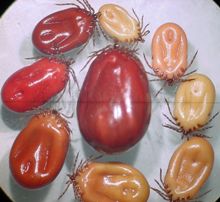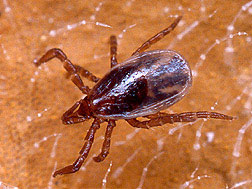
Blood suckers!
The Deer tick’s only source of food is the blood of their host.
Depending on their life cycle stage, larva, nymph, or adult, the
chosen host can vary from small animals like mice, squirrels and
birds to larger animals such as deer and humans. Most common
hosts are the white-footed mice and the
white-tailed deer.
Throughout the four stage life cycle, the tick feeds during the
larval, nymph, and adult stages. The longest feeding duration is
found in the adult females, this can be anywhere from a week to a
few weeks. The shortest feeding period is found in the larval
stage as it only lasts a few hours.
Once the adult feeding period has ceased the adult’s body can increase up to double its unfed size. Feeding duration and overall success can be greatly influenced by many factors some being; the choice of host, the attachment site on the host, and the host's immune response. Some ticks may attach to an area on the host where they mainly receive lymph or tissue and their feeding success will be greatly decreased compared to a tick that attached somewhere on which they receive a blood meal. The immune system of the host has an impact on the success because some host may have a stronger immune response to the ticks attachment and may be able to reject the tick whereas some host's immune and defense system may be suppressed by the components of the deer ticks saliva (explained more in depth as the page continues). Ticks that feed on immunologically naïve hosts will receive a more successful feeding. Fortunately, for the tick, temperature and humidity do not impact the success of feeding. Another factor that increases the duration and success of feeding is the time of feeding. A tick will increase their chances of a successful meal if they feed while the host is resting or sleeping

This photo shows the difference in the female's body before, after and during different intervals of feeding. The very top female is an unfed tick before attachment on the host. Going clockwise, around the center female, the female's body continues to grow in size, this is because it is taken as the feeding process continues. The very center tick is a fully engorged female tick after its feeding duration is complete.

